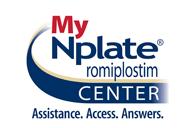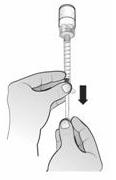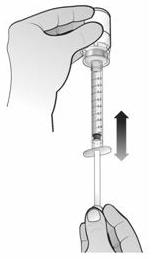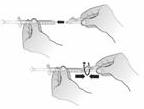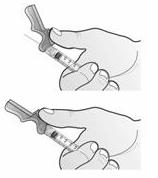|
2009年2月23日,欧盟委员会批准Nplate用于治疗那些对目前常用药无应答的免疫性血小板减少性紫癜(ITP),但它仅获准作为二线药物用于那些未进行脾脏切除,且不适宜接受手术治疗的成人ITP患者。
A subject's actual body weight at initiation of therapy should be used to calculate dose. The once weekly dose of romiplostim should be increased by increments of 1 μg/kg until the patient achieves a platelet count ≥ 50 x 109/l. Platelet counts should be assessed weekly until a stable platelet count (≥ 50 x 109/l for at least 4 weeks without dose adjustment) has been achieved. Platelet counts should be assessed monthly thereafter. A maximum once weekly dose of 10 μg/kg should not be exceeded. Adjust the dose as follows
A loss of response or failure to maintain a platelet response with romiplostim within the recommended dosing range should prompt a search for causative factors (see section 4.4, loss of response to romiplostim). Treatment discontinuation Treatment with romiplostim should be discontinued if the platelet count does not increase to a level sufficient to avoid clinically important bleeding after four weeks of romiplostim therapy at the highest weekly dose of 10 μg/kg. Patients should be clinically evaluated periodically and continuation of treatment should be decided on an individual basis by the treating physician. The reoccurrence of thrombocytopenia is likely upon discontinuation of treatment (see section 4.4). Elderly patients (≥ 65 years) No overall differences in safety or efficacy have been observed in patients < 65 and ≥ 65 years of age (see section 5.1). Although based on these data no adjustment of the dosing regimen is required for older patients, care is advised considering the small number of elderly patients included in the clinical trials so far. Paediatric population The safety and efficacy of Romiplostim in children aged under 18 years has not yet been established. No data are available. Patients with hepatic Impairment Romiplostim should not be used in patients with moderate to severe hepatic impairment (Child-Pugh score ≥ 7) unless the expected benefit outweighs the identified risk of portal venous thrombosis in patients with thrombocytopenia associated to hepatic insufficiency treated with thrombopoietin (TPO) agonists (see section 4.4). If the use of romiplostim is deemed necessary, platelet count should be closely monitored to minimise the risk of thromboembolic complications. Patients with renal impairment No formal clinical trials have been conducted in these patient populations. Nplate should be used with caution in these populations. Method of administration For subcutaneous use. After reconstitution of the powder, Nplate solution for injection is administered subcutaneously. The injection volume may be very small. Caution should be used during preparation of Nplate in calculating the dose and reconstitution with the correct volume of sterile water for injection. Special care should be taken to ensure that the appropriate volume of Nplate is withdrawn from the vial for subcutaneous administration – a syringe with graduations of 0.01 ml should be used. Patients who have a stable platelet count ≥ 50 x 109/l for at least 4 weeks without dose adjustment may, at the discretion of the supervising physician, self-administer Nplate solution for injection. Patients eligible for self-administration of Nplate should be trained in these procedures. After the first 4 weeks of self-administration, the patient should again be supervised while reconstituting and administering Nplate. Only patients who demonstrate the ability to reconstitute and self-administer Nplate are allowed to continue doing so. For instructions on reconstitution and administration of the medicinal product, see section 6.6. 4.3 Contraindications Hypersensitivity to the active substance or to any of the excipients listed in section 6.1 or to E. coli derived proteins. 4.4 Special warnings and precautions for use Reoccurrence of thrombocytopenia and bleeding after cessation of treatment Thrombocytopenia is likely to reoccur upon discontinuation of treatment with romiplostim. There is an increased risk of bleeding if romiplostim treatment is discontinued in the presence of anticoagulants or anti-platelet agents. Patients should be closely monitored for a decrease in platelet count and medically managed to avoid bleeding upon discontinuation of treatment with romiplostim. It is recommended that, if treatment with romiplostim is discontinued, ITP treatment be restarted according to current treatment guidelines. Additional medical management may include cessation of anticoagulant and/or antiplatelet therapy, reversal of anticoagulation, or platelet support. Increased bone marrow reticulin Increased bone marrow reticulin is believed to be a result of TPO receptor stimulation, leading to an increased number of megakaryocytes in the bone marrow, which may subsequently release cytokines. Increased reticulin may be suggested by morphological changes in the peripheral blood cells and can be detected through bone marrow biopsy. Therefore, examinations for cellular morphological abnormalities using peripheral blood smear and complete blood count (CBC) prior to and during treatment with romiplostim are recommended. See section 4.8 for information on the increases of reticulin observed in romiplostim clinical trials. If a loss of efficacy and abnormal peripheral blood smear is observed in patients, administration of romiplostim should be discontinued, a physical examination should be performed, and a bone marrow biopsy with appropriate staining for reticulin should be considered. If available, comparison to a prior bone marrow biopsy should be made. If efficacy is maintained and abnormal peripheral blood smear is observed in patients, the physician should follow appropriate clinical judgment, including consideration of a bone marrow biopsy, and the risk-benefit of romiplostim and alternative ITP treatment options should be re-assessed. Thrombotic/thromboembolic complications Platelet counts above the normal range present a risk for thrombotic/thromboembolic complications. The incidence of thrombotic/thromboembolic events observed in clinical trials was 6.0% with romiplostim and 3.6% with placebo. Caution should be used when administering romiplostim to patients with known risk factors for thromboembolism including but not limited to inherited (e.g. Factor V Leiden) or acquired risk factors (e.g. ATIII deficiency, antiphospholipid syndrome), advanced age, patients with prolonged periods of immobilisation, malignancies, contraceptives and hormone replacement therapy, surgery/trauma, obesity and smoking. Cases of thromboembolic events (TEEs), including portal vein thrombosis, have been reported in patients with chronic liver disease receiving romiplostim. Romiplostim should be used with caution in these populations. Dose adjustment guidelines should be followed (see section 4.2). Medication Errors Medication errors including overdose and underdose have been reported in patients receiving Nplate, dose calculation and dose adjustment guidelines should be followed (see section 4.2). Overdose may result in an excessive increase in platelet counts associated with thrombotic/thromboembolic complications. If the platelet counts are excessively increased, discontinue Nplate and monitor platelet counts. Reinitiate treatment with Nplate in accordance with dosing and administration recommendations. Underdose may result in lower than expected platelet counts and potential for bleeding. Platelet counts should be monitored in patients receiving Nplate (see sections 4.2, 4.4 and 4.9). Progression of existing Myelodysplastic Syndromes (MDS) A positive benefit/risk for romiplostim is only established for the treatment of thrombocytopenia associated with chronic ITP and romiplostim must not be used in other clinical conditions associated with thrombocytopenia. The diagnosis of ITP in adults and elderly patients should have been confirmed by the exclusion of other clinical entities presenting with thrombocytopenia, in particular the diagnosis of MDS must be excluded. A bone marrow aspirate and biopsy should normally have been done over the course of the disease and treatment, particularly in patients over 60 years of age, for those with systemic symptoms or abnormal signs such as increased peripheral blast cells. In clinical studies of treatment with romiplostim in patients with MDS, cases of transient increases in blast cell counts were observed and cases of MDS disease progression to AML were reported. In a randomized placebo-controlled trial in MDS subjects, treatment with romiplostim was prematurely stopped due to a numerical excess of disease progression to AML and an increase in circulating blasts greater than 10% in patients receiving romiplostim. Of the cases of MDS disease progression to AML that were observed, patients with RAEB-1 classification of MDS at baseline were more likely to have disease progression to AML compared to lower risk MDS. Romiplostim must not be used for the treatment of thrombocytopenia due to MDS or any other cause of thrombocytopenia other than ITP outside of clinical trials. Loss of response to romiplostim A loss of response or failure to maintain a platelet response with romiplostim treatment within the recommended dosing range should prompt a search for causative factors, including immunogenicity (see section 4.8) and increased bone marrow reticulin (see above). Effects of romiplostim on red and white blood cells Alterations in red (decrease) and white (increase) blood cell parameters have been observed in non-clinical toxicology studies (rat and monkey) but not in ITP patients. Monitoring of these parameters should be considered in patients treated with romiplostim. 4.5 Interaction with other medicinal products and other forms of interaction No interaction studies have been performed. The potential interactions of romiplostim with co-administered medicinal products due to binding to plasma proteins remain unknown. Medicinal products used in the treatment of ITP in combination with romiplostim in clinical trials included corticosteroids, danazol, and/or azathioprine, intravenous immunoglobulin (IVIG), and anti-D immunoglobulin. Platelet counts should be monitored when combining romiplostim with other medicinal products for the treatment of ITP in order to avoid platelet counts outside of the recommended range (see section 4.2). Corticosteroids, danazol, and azathioprine use may be reduced or discontinued when given in combination with romiplostim (see section 5.1). Platelet counts should be monitored when reducing or discontinuing other ITP treatments in order to avoid platelet counts below the recommended range (see section 4.2). 4.6 Fertility, pregnancy and lactation Pregnancy There are no or limited amount of data from the use of romiplostim in pregnant women. Studies in animals have shown that romiplostim crossed the placenta and increased foetal platelet counts. Post implantation loss and a slight increase in peri-natal pup mortality also occurred in animal studies (see section 5.3). Romiplostim is not recommended during pregnancy and in women of childbearing potential not using contraception. Breast-feeding It is unknown whether romiplostim/metabolites are excreted in human milk. A risk to the newborns/infants cannot be excluded. A decision must be made whether to discontinue breast-feeding or to discontinue/abstain from romiplostim therapy taking into account the benefit of breast feeding for the child and the benefit of therapy for the woman. Fertility There is no data available on fertility. 4.7 Effects on ability to drive and use machines Nplate has moderate influence on the ability to drive and use machines. In clinical trials, mild to moderate, transient bouts of dizziness were experienced by some patients. 4.8 Undesirable effects Summary of the safety profile Based on an analysis of all adult ITP patients receiving romiplostim in 4 controlled and 5 uncontrolled clinical trials, the overall subject incidence of all adverse reactions for romiplostim-treated subjects was 91.5% (248/271). The mean duration of exposure to romiplostim in this study population was 50 weeks. The most serious adverse reactions that may occur during Nplate treatment include: reoccurrence of thrombocytopenia and bleeding after cessation of treatment, increased bone marrow reticulin, thrombotic/thromboembolic complications, medication errors and progression of existing MDS to AML. The most common adverse reactions observed include hypersensitivity reactions (including cases of rash, urticaria and angioedema) and headache. Tabulated list of adverse reactions Frequencies are defined as: very common (≥ 1/10), common (≥ 1/100 to < 1/10), uncommon (≥ 1/1000 to < 1/100), rare (≥ 1/10,000 to < 1/1,000); very rare (< 1/10,000) and not known (cannot be estimated from the available data). Within each MedDRA system organ class and frequency grouping, undesirable effects are presented in order of decreasing incidence.
** Hypersensitivity reactions including cases of rash, urticaria, and angioedema Description of selected adverse reactions In addition the reactions listed below have been deemed to be related to romiplostim treatment. Thrombocytosis Based on an analysis of all adult ITP patients receiving romiplostim in 4 controlled and 5 uncontrolled clinical trials, 3 events of thrombocytosis were reported, n = 271. No clinical sequelae were reported in association with the elevated platelet counts in any of the 3 subjects. Thrombocytopenia after cessation of treatment Based on an analysis of all adult ITP patients receiving romiplostim in 4 controlled and 5 uncontrolled clinical trials, 4 events of thrombocytopenia after cessation of treatment were reported, n = 271 (see section 4.4). Progression of existing Myelodysplastic Syndromes (MDS) In a randomized placebo-controlled trial in MDS subjects treatment with romiplostim was prematurely stopped due to a numerical increase in cases of MDS disease progression to AML and transient increases in blast cell counts in patients treated with romiplostim compared to placebo. Of the cases of MDS disease progression to AML that were observed, patients with RAEB-1 classification of MDS at baseline were more likely to have disease progression to AML (see section 4.4). Overall survival was similar to placebo. Increased bone marrow reticulin In clinical trials, romiplostim treatment was discontinued in 4 of the 271 patients because of bone marrow reticulin deposition. In 6 additional patients reticulin was observed upon bone marrow biopsy (see section 4.4). Immunogenicity Clinical trials in adult ITP patients examined antibodies to romiplostim. While 5.8% and 3.9% of the subjects were positive for developing binding antibodies to romiplostim and TPO respectively, only 2 subjects (0.4%) were positive for neutralizing antibodies to romiplostim but these antibodies did not cross react with endogenous TPO. Both subjects tested negative for neutralising antibodies to romiplostim at 4 months after the end of dosing. The incidence of pre-existing antibodies to romiplostim and TPO was 8.0% and 5.4%, respectively. As with all therapeutic proteins, there is a potential for immunogenicity. If formation of neutralising antibodies is suspected, contact the local representative of the Marketing Authorisation Holder (see section 6 of the Package Leaflet) for antibody testing. Reporting of suspected adverse reactions Reporting suspected adverse reactions after authorisation of the medicinal product is important. It allows continued monitoring of the benefit/risk balance of the medicinal product. Healthcare professionals are asked to report any suspected adverse reactions via Yellow Card Scheme Website: www.mhra.gov.uk/yellowcard 4.9 Overdose No adverse effects were seen in rats given a single dose of 1000 μg/kg or in monkeys after repeated administration of romiplostim at 500 µg/kg (100 or 50 times the maximum clinical dose of 10 µg/kg, respectively). In the event of overdose, platelet counts may increase excessively and result in thrombotic/thromboembolic complications. If the platelet counts are excessively increased, discontinue Nplate and monitor platelet counts. Reinitiate treatment with Nplate in accordance with dosing and administration recommendations (see sections 4.2 and 4.4). 5. Pharmacological properties 5.1 Pharmacodynamic properties Pharmacotherapeutic group: Antihaemorrhagics, other systemic hemostatics, ATC code: B02BX04 Mechanism of action Romiplostim is an Fc-peptide fusion protein (peptibody) that signals and activates intracellular transcriptional pathways via the TPO receptor (also known as cMpl) to increase platelet production. The peptibody molecule is comprised of a human immunoglobulin IgG1 Fc domain, with each single-chain subunit covalently linked at the C-terminus to a peptide chain containing 2 TPO receptor-binding domains. Romiplostim has no amino acid sequence homology to endogenous TPO. In pre-clinical and clinical trials no anti-romiplostim antibodies cross reacted with endogenous TPO. Clinical efficacy and safety The safety and efficacy of romiplostim have been evaluated for up to 3 years of continuous treatment. In clinical trials, treatment with romiplostim resulted in dose-dependent increases in platelet count. Time to reach the maximum effect on platelet count is approximately 10-14 days, and is independent of the dose. After a single subcutaneous dose of 1 to 10 µg/kg romiplostim in ITP patients, the peak platelet count was 1.3 to 14.9 times greater than the baseline platelet count over a 2 to 3 week period and the response was variable among patients. The platelet counts of ITP patients who received 6 weekly doses of 1 or 3 µg/kg of romiplostim were within the range of 50 to 450 x 109/l for most patients. Of the 271 patients who received romiplostim in ITP clinical trials, 55 (20%) were age 65 and over, and 27 (10%) were 75 and over. No overall differences in safety or efficacy have been observed between older and younger patients in the placebo-controlled studies. Results from pivotal placebo-controlled studies The safety and efficacy of romiplostim was evaluated in two placebo-controlled, double-blind studies in adults with ITP who had completed at least one treatment prior to study entry and are representative of the entire spectrum of such ITP patients. Study S1 (212) evaluated patients who were non-splenectomised and had an inadequate response or were intolerant to prior therapies. Patients had been diagnosed with ITP for approximately 2 years at the time of study entry. Patients had a median of 3 (range, 1 to 7) treatments for ITP prior to study entry. Prior treatments included corticosteroids (90% of all patients), immunoglobulins (76%), rituximab (29%), cytotoxic therapies (21%), danazol (11%), and azathioprine (5%). Patients had a median platelet count of 19 x 109/l at study entry. Study S2 (105) evaluated patients who were splenectomised and continued to have thrombocytopenia. Patients had been diagnosed with ITP for approximately 8 years at the time of study entry. In addition to a splenectomy, patients had a median of 6 (range, 3 to 10) treatments for ITP prior to study entry. Prior treatments included corticosteroids (98% of all patients), immunoglobulins (97%), rituximab (71%), danazol (37%), cytotoxic therapies (68%), and azathioprine (24%). Patients had a median platelet count of 14 x 109/l at study entry. Both studies were similarly designed. Patients (≥ 18 years) were randomised in a 2:1 ratio to receive a starting dose of romiplostim 1 µg/kg or placebo. Patients received single subcutaneous weekly injections for 24 weeks. Doses were adjusted to maintain (50 to 200 x 109/l) platelet counts. In both studies, efficacy was determined by an increase in the proportion of patients who achieved a durable platelet response. The median average weekly dose for splenectomised patients was 3 µg/kg and for non-splenectomised patients was 2 µg/kg. A significantly higher proportion of patients receiving romiplostim achieved a durable platelet response compared to patients receiving placebo in both studies. Following the first 4-weeks of study romiplostim maintained platelet counts ≥ 50 x 109/l in between 50% to 70% of patients during the 6 month treatment period in the placebo-controlled studies. In the placebo group, 0% to 7% of patients were able achieve a platelet count response during the 6 months of treatment. A summary of the key efficacy endpoints is presented below. Summary of key efficacy results from placebo-controlled studies
In both placebo-controlled, double-blind studies, patients already receiving ITP medical therapies at a constant dosing schedule were allowed to continue receiving these medical treatments throughout the study (corticosteroids, danazol and/or azathioprine). Twenty-one non-splenectomised and 18 splenectomised patients received on-study ITP medical treatments (primarily corticosteroids) at the start of study. All (100%) splenectomised patients who were receiving romiplostim were able to reduce the dose by more than 25% or discontinue the concurrent ITP medical therapies by the end of the treatment period compared to 17% of placebo treated patients. Seventy-three percent of non-splenectomised patients receiving romiplostim were able to reduce the dose by more than 25% or discontinue concurrent ITP medical therapies by the end of the study compared to 50% of placebo treated patients (see section 4.5). Bleeding events Across the entire ITP clinical programme an inverse relationship between bleeding events and platelet counts was observed. All clinically significant (≥ grade 3) bleeding events occurred at platelet counts < 30 x 109/l. All bleeding events ≥ grade 2 occurred at platelet counts < 50 x 109/l. No statistically significant differences in the overall incidence of bleeding events were observed between Nplate and placebo treated patients. In the two placebo-controlled studies, 9 patients reported a bleeding event that was considered serious (5 [6.0%] romiplostim, 4 [9.8%] placebo; Odds Ratio [romiplostim/placebo] = 0.59; 95% CI = (0.15, 2.31)). Bleeding events that were grade 2 or higher were reported by 15% of patients treated with romiplostim and 34% of patients treated with placebo (Odds Ratio; [romiplostim/placebo] = 0.35; 95% CI = (0.14, 0.85)). Paediatric population The European Medicines Agency has deferred the obligation to submit the results of studies with Nplate in one or more subsets of the paediatric population in the treatment of immune thrombocytopenia (idiopathic thrombocytopenic purpura) (see section 4.2 for information on paediatric use). 5.2 Pharmacokinetic properties The pharmacokinetics of romiplostim involved target-mediated disposition, which is presumably mediated by TPO receptors on platelets and other cells of the thrombopoietic lineage such as megakaryocytes. Absorption After subcutaneous administration of 3 to 15 μg/kg romiplostim, maximum romiplostim serum levels in ITP patients were obtained after 7-50 hours (median 14 hours). The serum concentrations varied among patients and did not correlate with the dose administered. Romiplostim serum levels appear inversely related to platelet counts. Distribution The volume of distribution of romiplostim following intravenous administration of romiplostim decreased nonlinearly from 122, 78.8, to 48.2 ml/kg for intravenous doses of 0.3, 1.0 and 10 μg/kg, respectively in healthy subjects. This non-linear decrease in volume of distribution is in line with the (megakaryocyte and platelet) target-mediated binding of romiplostim, which may be saturated at the higher doses applied. Elimination Elimination half-life of romiplostim in ITP patients ranged from 1 to 34 days (median, 3.5 days). The elimination of serum romiplostim is in part dependent on the TPO receptor on platelets. As a result for a given dose, patients with high platelet counts are associated with low serum concentrations and vice versa. In another ITP clinical trial, no accumulation in serum concentrations was observed after 6 weekly doses of romiplostim (3 μg/kg). Special populations Pharmacokinetics of romiplostim in patients with renal and hepatic impairment has not been investigated. Romiplostim pharmacokinetics appear not affected by age, weight and gender to a clinically significant extent. 5.3 Preclinical safety data Multiple dose romiplostim toxicology studies were conducted in rats for 4 weeks and in monkeys for up to 6 months. In general, effects observed during these studies were related to the thrombopoietic activity of romiplostim and were similar regardless of study duration. Injection site reactions were also related to romiplostim administration. Myelofibrosis has been observed in the bone marrow of rats at all tested dose levels. In these studies, myelofibrosis was not observed in animals after a 4-week post-treatment recovery period, indicating reversibility. In 1-month rat and monkey toxicology studies, a mild decrease in red blood cell count, haematocrit and haemoglobin was observed. There was also a stimulatory effect on leukocyte production, as peripheral blood counts for neutrophils, lymphocytes, monocytes, and eosinophils were mildly increased. In the longer duration chronic monkey study, there was no effect on the erythroid and leukocytic lineages when romiplostim was administered for 6 months where the administration of romiplostim was decreased from thrice weekly to once weekly. Additionally, in the phase 3 pivotal studies, romiplostim did not affect the red blood cell and white blood cells lineages relative to placebo treated subjects. Due to the formation of neutralising antibodies pharmacodynamic effects of romiplostim in rats were often decreasing at prolonged duration of administration. Toxicokinetic studies showed no interaction of the antibodies with the measured concentrations. Although high doses were tested in the animal studies, due to differences between the laboratory species and humans with regard to the sensitivity for the pharmacodynamic effect of romiplostim and the effect of neutralising antibodies, safety margins cannot be reliably estimated. Carcinogenesis The carcinogenic potential of romiplostim has not been evaluated. Therefore, the risk of potential carcinogenicity of romiplostim in humans remains unknown. Reproductive toxicology In all developmental studies neutralising antibodies were formed, which may have inhibited romiplostim effects. In embryo-foetal development studies in mice and rats, reductions in maternal body weight were found only in mice. In mice there was evidence of increased post-implantation loss. In a prenatal and postnatal development study in rats an increase of the duration of gestation and a slight increase in the incidence of peri-natal pup mortality was found. Romiplostim is known to cross the placental barrier in rats and may be transmitted from the mother to the developing foetus and stimulate foetal platelet production. Romiplostim had no observed effect on the fertility of rats. 6. Pharmaceutical particulars 6.1 List of excipients Mannitol (E421) Sucrose L-histidine Hydochloric acid (for pH adjustment) Polysorbate 20 Solvent: Water for injections 6.2 Incompatibilities This medicinal product must not be mixed with other medicinal products, except those mentioned in section 6.6. 6.3 Shelf life 3 years. After reconstitution: Chemical and physical in-use stability has been demonstrated for 24 hours at 25°C and for 24 hours at 2°C – 8°C, when protected from light and kept in the original vial. From a microbiological point of view, the medicinal product should be used immediately. If not used immediately, in-use storage times and conditions prior to use are the responsibility of the user and would normally not be longer than 24 hours at 25°C or 24 hours in a refrigerator (2°C – 8°C), protected from light. 6.4 Special precautions for storage Store in a refrigerator (2°C – 8°C). Do not freeze. Store in the original carton in order to protect from light. May be temporarily removed from the refrigerator for a maximum period of 24 hours at room temperature (up to 25°C). For storage conditions after reconstitution of the medicinal product, see section 6.3. 6.5 Nature and contents of container Powder: 5 ml vial (type 1 clear glass) with a stopper (chlorobutyl rubber), seal (aluminium) and a flip-off cap (polypropylene). Solvent: Pre-filled syringe (type 1 clear glass with bromobutyl rubber plunger) containing 0.72 ml of water for injections for reconstitution. Pre-filled syringe (type 1 clear glass with bromobutyl rubber plunger) containing 1.2 ml of water for injections for reconstitution. Pack size: Nplate is supplied as a 1 pack or multipack comprising 4 packs. Each pack contains: 1 vial of 250 micrograms romiplostim. 1 vial of 500 micrograms romiplostim. 1 pre-filled syringe containing 0.72 ml of water for injections for reconstitution. 1 pre-filled syringe containing 1.2 ml of water for injections for reconstitution. 1 plunger rod for the pre-filled syringe. 1 sterile vial adapter. 1 sterile 1 ml Luer lock syringe. 1 sterile safety needle. 4 alcohol swabs. Not all pack sizes may be marketed. 6.6 Special precautions for disposal and other handling Nplate is a sterile but unpreserved medicinal product and is intended for single use only. Nplate should be reconstituted in accordance with good aseptic practice. Nplate 250 micrograms powder for solution for injection should be reconstituted with 0.72 ml sterile water for injections, yielding a deliverable volume of 0.5 ml. An additional overfill is included in each vial to ensure that 250 µg of romiplostim can be delivered. Nplate 500 micrograms powder for solution for injection should be reconstituted with 1.2 ml sterile water for injections, yielding a deliverable volume of 1 ml. An additional overfill is included in each vial to ensure that 500 µg of romiplostim can be delivered. From a microbiological point of view, the product should be used immediately. If not used immediately, in-use storage times and conditions prior to use are the responsibility of the user and would normally not be longer than 24 hours at 25°C or 24 hours in a refrigerator (2°C – 8°C), protected from light.
Any unused medicinal product or waste material should be disposed of in accordance with local requirements. 7. Marketing authorisation holder Amgen Europe B.V. Minervum 7061 4817 ZK Breda The Netherlands 8. Marketing authorisation number(s) EU/1/08/497/005 EU/1/08/497/006 EU/1/08/497/007 EU/1/08/497/008 9. Date of first authorisation/renewal of the authorisation Date of first authorisation: 4 February 2009 Date of latest renewal: 20 December 2013 10. Date of revision of the text June 2015 Detailed information on this medicinal product is available on the website of the European Medicines Agency http://www.ema.europa.eu | |||||||||||||||||||||||||||||||||||||||||||||||||||||||||||||||||||||||||||||||||||||||||||||||||||||||||||||||||||||||||||||||||||||||||||||||||||||||||||||||||||||||||||||||||||||||||||||||||||||||||||||||||||||||||||||||||||||||||||||||||||||||||||||||


